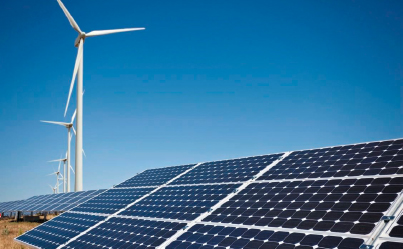LA HORA DE LAS ENERGÍAS RENOVABLES
- 4 de abril de 2017
 [tp lang=»es» not_in=»en»]
[tp lang=»es» not_in=»en»]
Los Mercados Eléctricos Latinoamericanos, donde se ubica la región CIER, tienen poco más de 100 años de existencia. Tan solo 10 años atrás esta región se alimentaba casi exclusivamente, y como había ocurrido desde su origen, con centrales hidroeléctricas de gran porte y centrales térmicas alimentadas por combustibles fósiles.
Impulsada por una toma de conciencia ambiental frente a la evidencia de los efectos del cambio climático y también por las incertidumbres sobre los costos de los combustibles fósiles siempre asociados a cuestiones geopolíticas, comenzaron a surgir, al principio muy tímidamente, las llamadas Energías Renovables No Convencionales (ERNC).
Este término ERNC incluye a la energía eólica, a la solar (tanto fotovoltaica como térmica) a la biomasa, a la geotérmica y a la mini hidráulica.
Por sus características intrínsecas de ser auto despachable o auto gestionable, debido a depender de un recurso natural no almacenable, se las vio desde un principio con capacidad solamente marginal para contribuir a la solución de los problemas energéticos. Incluso autoridades que las impulsaban decían frases como “no pretendemos que sea la solución definitiva, pero sí que hagan su contribución al desarrollo energético”.
El advenimiento de las ERNC vino de la mano de algunos mitos que actuaron como barreras para su desarrollo, entre ellos se pueden mencionar:
- Que la energía producida es de mala calidad y solo puede introducirse en forma parcial o marginal.
- Que se trata de una forma de generación muy costosa.
- Que las variaciones de potencia horaria son muy bruscas y la hacen ingobernable.
- Que las ERNC “consumen” mucha red de transmisión.
- Que siempre precisan gran cantidad de respaldo firme. Por cada MW eólico que se instale es necesario instalar un MW térmico y de funcionamiento muy flexible (turbinas de gas y motores).
Sin embargo, poco a poco las ERNC, asociadas a un gran avance tecnológico, fueron derribando esas barreras o mitos.

Hoy nadie duda de la calidad de energía que producen las ERNC. De hecho, han vuelto obsoletas normas creadas para controlar los perjuicios que ellas traían a los sistemas eléctricos.
Las subastas realizadas en los países de la región CIER han demostrado que son muy competitivas desde el punto de vista económico.
Su asociación en la operación conjunta con centrales hidroeléctricas y su dispersión geográfica han eliminado el problema de las variaciones de potencia, demostrando que las hidroeléctricas convencionales y las ERNC forman un “matrimonio ideal”.
Los factores de capacidad alcanzados por las ERNC son similares a los de las hidroeléctricas (razón de ser de los sistemas de transmisión) por lo que son perfectamente compatibles con los sistemas de transmisión existentes y además, debido a que generalmente se trata de generación distribuida, contribuyen a aliviar la congestión en el transporte.
Si bien los reglamentos actuales que regulan los mercados eléctricos no reconocen potencia firme de las ERNC, por que no la tienen en el sentido convencional, sí es cierto que colaboran en forma sustancial en disminuir las necesidades de potencia firme de los sistemas que integran, aumentando la confiabilidad de los mismos, razón de ser de la definición y exigencia de potencia firme.
Por otro lado la dispersión geográfica de las ERNC disminuye las variaciones de su producción, aumentando su “firmeza” y haciendo necesario la existencia de interconexiones internacionales. Basado en mi experiencia personal de casi 40 años lidiando con la operación de centrales de generación de tipo muy variado, estoy convencido que el futuro de América Latina puede ser 100 % renovable. Para eso será necesario cambiar los paradigmas de cómo operar los sistemas eléctricos, es decir que se deben operar teniendo en cuenta las características de las ERNC y no hacerlo como si se tratara de fuentes convencionales. Habrá que adaptar los reglamentos del mercado a las nuevas realidades. La energía hidroeléctrica convencional y eventualmente con bombeo será la que logre hacer gestionable a las ERNC. Las centrales térmicas deberán adaptarse a su nuevo rol de “respaldo de los sistemas eléctricos”.
Finalmente, creo firmemente que las ERNC serán los catalizadores de las interconexiones internacionales, razón de ser de nuestra querida CIER.
Fuente: CIER – Revista Nº72 – www.cier.org
[/tp]
[tp lang=»en» not_in=»es»]
The Latin American Electric Markets, where the CIER region is located, have little over 100 years of existence. Only 10 years ago this region was fed almost exclusively, and as had happened since its origin, with large hydroelectric power stations and fossil fuel power stations.
Driven by an environmental awareness based on the evidence of the effects of climate change and also by the uncertainties about the costs of fossil fuels always associated with geopolitical issues, the so-called » Non-Conventional Renewable Energies» (NCRE) began to emerge.
This term NCRE includes wind energy, solar (both photovoltaic and thermal), biomass, geothermal, and small hydro.
Due to the intrinsic characteristics of being self-manageable, and a dependence on a non-storable natural resource, they were seen from the outset with only marginal capacity to contribute to the solution of energy problems. Even authorities that encouraged them said phrases like «we do not pretend to be the definitive solution, but they do make their contribution to energy development.»
The advent of the NCRE came along with some myths that acted as barriers to its development, these included:
- That the energy produced is of poor quality and can only be introduced partially or marginally.
- That it is an expensive form of energy generation.
- That the hourly power variations are very abrupt and make it unmanageable.
- That NCREs «consume» a lot of transmission network.
- The NCREs always need a lot of firm backing. For every wind turbine MW installed it is necessary to install a thermal MW, and a very flexible operation (gas turbines and motors).
However, the NCREs were gradually associated with a great technological advance, and brought down these barriers or myths.

Today, no one doubts the quality and benefits of energy produced by NCREs.
Auctions held in the countries of the CIER region have shown that they are highly competitive from an economic stand point.
Their association in the joint operation with hydroelectric power stations and their geographic dispersion have eliminated the problem of variations in power, demonstrating that conventional hydroelectric plants and NCREs form an «ideal alliance».
The capacity factors achieved by the NCREs are similar to those of hydroelectric plants, so they are perfectly compatible with existing transmission systems and, in addition, because they are generally distributed generation, they contribute to alleviate congestion in transport.
Although the current regulations regulating electric markets do not recognize firm strength of the NCREs, it is true that these energies collaborate in a substantial way in diminishing the firm power needs of the systems that are integrated and increase the reliability of the same; reason of being of the definition and requirement of firm power. On the other hand, the geographic dispersion of the NCRE reduces the variations of its production, increasing its «firmness» and making international interconnections necessary. Based on my personal experience of almost 40 years dealing with the operation of generation plants of a very varied type, I am convinced that the future of Latin America can be 100% renewable. For that it will be necessary to change the paradigms of how to operate the electrical systems, that is to say that they must be operated taking into account the characteristics of the NCRE and not to do it as if it were conventional sources. Market regulations will have to be adapted to the new realities. The conventional hydroelectric power, and eventually with pumping, will achieve making manageable the NCREs. The thermal power plants will have to adapt to their new role of «backup of the electrical systems».
Finally, I firmly believe that the NCREs will be the boosters of international interconnections, reason of being of our beloved CIER.
Source: CIER – www.cier.org
[/tp]




